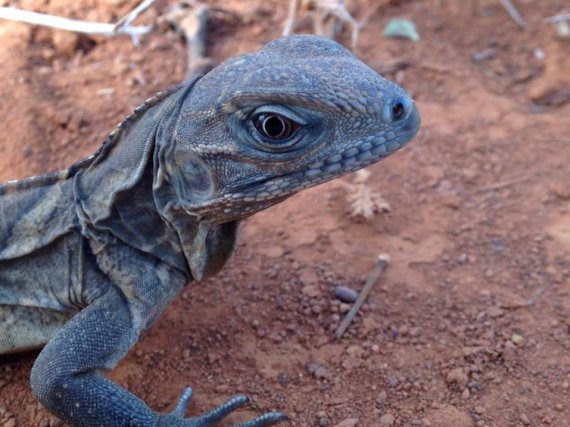Baby Ricord’s Iguana ©Stesha Pasachnik
Caribbean rock iguanas (Cyclura) are among the most endangered lizards in the world. Relatively little is known about what they eat. Martín collected the animals’ scat and analysed the contents in order to determine what they eat. ‘We discovered that there is a core diet of plant species that Iguanas tend to prefer.’
We discovered that there is a core diet of plant species that Iguanas tend to prefer.
According to Martín, this information is important for the protection of these iguanas. ‘This information can be used for instance by managers for making good restoration plans in the area and to take into account when choosing a space for reintroducing the species.’
Researcher Victor Martín sifting through poo © Stesha Pasachnik
For this study, which was carried out in collaboration with the Institute for Conservation Research of the San Diego Zoo, the PhD candidate travelled to the Jaragua National Park in the south-western part of the Dominican Republic. That is where the iguanas nest on the limestone terraces which characterise the region. Martín collected scat of two different species of rock iguanas: the rhinoceros rock iguana (Cyclura cornuta) and the Ricord’s rock iguana (Cyclura ricordii). ‘Iguanas have quite high home range fidelity, so they remain within the same small area almost all time. This makes it relatively easy to know where to find the samples along the tracks and in the surroundings.’
The greatest challenge is the environment.
In three months’ time, Martín collected a total of 158 scat samples on three locations in the park. This was quite a challenge. ‘The greatest challenge is the environment. In tropical dry forest you find mostly cactus plants, and the plant species that do not have thorns they are poisonous, so you can not touch anything. This combined with the high temperatures and the long walking distances of almost ten kilometres per day, makes the landscape quite demanding.’
Drudgery
At this point, the drudgery still had to start: sieving through the scat and determining how many plant remnants, berries, insects and other materials it contained. It turned out that there are five plants species that the iguanas enjoy eating the most. They didn’t necessarily go for the most readily available, but seemed to seek out certain plants. ‘Iguanas were thought to be completely generalist, and in fact they are showing preference for certain plants.’ To his great surprise, Martín also encountered remnants of other iguanas in the scat. ‘These Iguana species were assumed to be completely herbivorous some time ago. However, the trend is changing and they are beginning to be considered as occasionally animal feeders. Mostly the juveniles may eat more animal matter such as arthropods for developing and growth, but still there is no complete information about that. Now it appears they also practice cannibalism.’
It appears they also practice cannibalism.
Martín only performed this study during the nesting season. ‘In the future we would like to know what these animals eat the rest of the year and how this relates with the dietary needs and availability of plants and fruits.’

